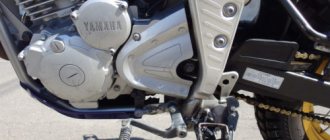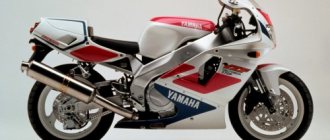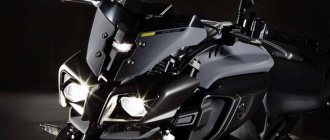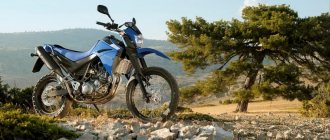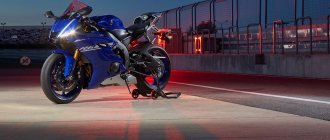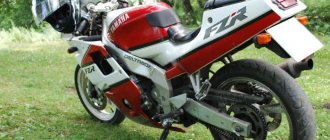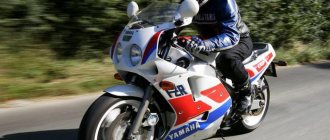| Yamaha SRV250 (1992-1993) | Yamaha SRV250S (1993) | Yamaha SRV250T (1993) | Yamaha SRV250G (1995) |
| Yamaha SRV250 Renaissa (1996) | Yamaha SRV250 Renaissa (1997) | Yamaha SRV250J – SRV250K (1997-1998) |
Model of a retro classic motorcycle Yamaha SRV 250
appeared in 1992 on the domestic Japanese market. The model was a classic motorcycle with a 2-cylinder V-shaped air-cooled engine, taken from the Yamaha Virago 250 and producing up to 27 hp. power.
In 1993, the SRV250 line was replenished with more modifications: Yamaha SRV250S
(version with a small windshield, rear shock absorbers with remote reservoirs and two-tone coloring of the tank) and
Yamaha SRV250T
(same as the regular version + trunk in place of the passenger seat).
Since 1995, the Yamaha SRV 250 model has become available on the Oceania market.
In 1996, the model underwent restyling and was replaced by a new model - Yamaha SRV250 Renaissa
. This generation differed in the shape of the headlight, frame, instrument panel, saddle and rear end. The coloring also changed - the model was now available in silver, yellow and orange. Since 1997, this generation has been available in the Oceania market, while this was the last production year for the Japanese market.
1998 was the last year of production of the model, after which it finally left the market and received no further development. It is also worth noting that the Renaissa prefix was used only in the Japanese market - in the Oceania market this model was sold as the Yamaha SRV250J
(1997) and
Yamaha SRV250K
(1998).
Of the features of all modifications of the Yamaha SRV250, it should be noted a simple steel frame, suspension in the form of a conventional telescopic fork at the front and a double shock absorber at the rear, front disc and rear drum brakes, 18′ spoked wheels, a 5-speed gearbox and a minimum curb weight of 152 kg.
The main competitors of the Yamaha SRV 250 in the class:
- Honda Rebel 250 / Honda Magna 250 / Honda VTR 250
- Kawasaki Estrella 250
- Suzuki TU 250
Brief history of the model
- 1992 - start of production and sales.
Model
: Yamaha SRV250 (Japan).
Factory designation
: 4DN1.
- 1993 - appearance of new modifications - Yamaha SRV250V and Yamaha SRV250T.
Model
: Yamaha SRV250;
Yamaha SRV250S; Yamaha SRV250T (Japan). Factory designation
: 4DN2; 4DN3; 4DN4.
- 1994 - model not produced.
- 1995 - no significant changes.
Model
: Yamaha SRV250G (Oceania).
Factory designation
: 4RK1.
- 1996 - restyling of the model. One modification remains: the prefix Reanaissa is added.
Model
: Yamaha SRV250 Renaissa (Japan).
Factory designation
: 4DN5.
- 1997 - The coloring of the domestic Japanese versions changes (instead of a black muffler and engine covers, chrome and silver are used).
Model
: Yamaha SRV250 Renaissa;
Yamaha SRV250J (Japan, Oceania). Factory designation
: 4DN6; 4RK3.
- 1998 is the last year of production.
Model
: Yamaha SRV250K (Oceania).
Factory designation
: 4RK4.
Dimensions and weight
The bike has very modest dimensions: its weight is 154 kg, the seat height is 770 mm, and the wheelbase is only 1390 mm. The average fuel consumption of 2.7 liters per hundred kilometers is absolutely not scary, because the tank volume here is sufficient: 13 liters. Given the small size of the SRV 250 Renaissa, it's safe to say that this bike will be very uncomfortable for people taller than 180cm, and even those taller than 170cm may find it difficult.
Specifications
Technical characteristics of Yamaha SRV 250:
| Model | Yamaha SRV250 |
| Motorcycle type | retro classic |
| Year of issue | 1992-1998 |
| Frame | steel tubular |
| engine's type | 2-cylinder, 4-stroke, V-shaped |
| Working volume | 248 cm³ |
| Bore/Stroke | 49.0 x 66.0 mm |
| Compression ratio | 9.8:1 |
| Cooling | air |
| Number of valves per cylinder | SOHC, 2 valves per cylinder |
| Fuel supply system | Carburetor, 2x Mikuni BDS26 |
| Ignition type | TCI |
| Maximum power | 27.0 hp (19.8 kW) at 8500 rpm |
| Maximum torque | 24.0 Nm (2.5 kg-m) at 6500 rpm |
| Clutch | Multi-disc in oil bath, cable drive |
| Transmission | 5-speed |
| type of drive | chain |
| Front tire size | 90/90-18 51S |
| Rear tire size | 110/90-18 61S |
| Front brakes | 1 disc, 282 mm, 2-piston caliper |
| Rear brakes | drum |
| Front suspension | Telescopic fork, travel - 140 mm |
| Rear suspension | Pendulum with two shock absorbers, stroke - 100 mm |
| Motorcycle length | 2095 mm – SRV250 2060 mm – Renaissa |
| Motorcycle width | 720 mm – SRV250 685 mm – Renaissa |
| Motorcycle height | 1055 mm – SRV250 1050 mm – Renaissa |
| Wheelbase | 1390 mm |
| Seat height | 770 mm – SRV250 (Oceania), Renaissa 760 mm – SRV250 (Japan) |
| Minimum ground clearance (clearance) | 140 mm |
| Acceleration 0-100 km/h (0-60 mph) | |
| Maximum speed | 130 km/h |
| Gas tank capacity | 13.0 l (including reserve - 2.5 l) - SRV250 11.0 l (including reserve - 2.5 l) - Renaissa |
| Motorcycle weight (curb) | 154 kg – SRV250 152 kg – Renaissa |
Bike features
Here are its main features:
- This is an intra-Japanese model;
- the engine is borrowed from the XV 250 Virago;
- low center of gravity, and as a result, easy to drive.
The bike will suit many people, and we’re not just talking about class connoisseurs. The Yamaha SRV 250 Renaissa can make a good cafe racer, despite the fact that the V-type engine is not very conducive to this. In addition, this is a cheap model, and by purchasing it on the secondary market, you can save a lot of money.
Reviews
Reviews about Yamaha SRV 250:
Expand Collapse
Its calm 120, that with one pilot, that together with the passenger pulled like an elephant. But I didn’t go more than 140. He looks stylish. I actually noticed a disease common to many old Yamahas - when parked for a long time, it refuses to start. It is corrected by falling to one side (but not quite on the floor) while turning the starter.
By the end of the season I realized that I had already outgrown it, although I was very sorry to part with it, I gave it into good hands. I would like to know how it is doing, my first jap, for which there was a place in the stern heart of a rocker...
So I’ll write a little because... I had the good fortune to own this model. Yamaha SRV 250, 27 hp maximum speed 140km/h. I'm sure the girl would love this motorcycle, the rumble of the exhaust sounds like a cat purring. Correlate the new ebr and the old SRV? Yes, definitely SRV. I drove an ebre, well, it’s more powerful than a minar, it’s light, but compared to the SRV it’s just heaven and earth, and not only in terms of power, even in appearance, and even in sound...
The incubation period of the disease called “motorcycles” lasted for a long time, and then, one fine day, I decided and bought it. I chose for a long time, looked closely, almost bought a Honda VRX400, but fate decreed otherwise, I took tuning forks (Yamaha), and I don’t regret it
long time, looked closely, almost bought a Honda VRX400, but fate decreed otherwise, I took tuning forks (Yamaha), and I don’t regret it
So, motorcycle Yamaha SRV250, 1991. in excellent condition, originally from Japan, purchased in St. Petersburg, delivered to Ulyanovsk by PEK in proper quality 
The first time I sat down I was convinced how comfortable it was! Light, handles like Yobrik, sound, mmmm! After all, a V-shape is a V-shape - the purr of a cat! From the outside you can’t tell by the sound that the volume is only 250 cubic meters.
Light, handles like Yobrik, sound, mmmm! After all, a V-shape is a V-shape - the purr of a cat! From the outside you can’t tell by the sound that the volume is only 250 cubic meters.
After purchasing it, I gave it to a local mechanic for diagnostics, fortunately, little had to be changed, the bike was in excellent condition, only the carbs were slightly out of sync, the chain was cleaned and lubricated, and the fluids were changed.
The Yamaha SRV250 is an ideal donor for building a cafe racer. The motorcycle is equipped with a Yamaha 250 Virago V-twin engine that produces 27 hp. power and is housed in a frame similar to the iconic Norton Featherbed frame. Knowing this, I’ve already sketched out future alterations in my head, although it looks great even without them! 
It should be noted that this motorcycle took first place in its class in 1993, 27 hp, and this says something. On the road from PEC to the garage, it easily did 130 km/h, so “a ton”, I think , he will master it
On the road from PEC to the garage, it easily did 130 km/h, so “a ton”, I think , he will master it
At the age of 17, I clearly decided for myself: “I will have the rights to the motorcycle, just like the motorcycle itself.” Although I had a motorcycle at that time, Minsk 95. unpretentious horse. But I was honest with myself and understood that our motorcycles are for lovers of LEGO construction kits (and don’t throw feces at me, this is my opinion which I express in my post). Having successfully passed the school exams, I was preparing to take my license. I passed my driving test better than my school exams, as you all understand :). I started saving for Jap. As a sane person, I decided that sitting down after 125 cubes (and even Soviet ones) for something serious would not benefit my body. And the budget was too small, 40-60 thousand rubles. All winter I walked around motorcycle dealerships, chose, looked closely, listened, and surfed the forums. In February, patience ran out and it became unbearable. While I was visiting showrooms, I spotted one very nice copy of the Yamaha SRV 250 from 1993,
who stood lonely in the corner and no one rolled him out of there. It cost 54 thousand wooden ones. Fortunately, the fortune had already been made. After googling, I found information that this motorcycle took first place in its class in 1993, 27 hp. and if you believe some sources, the fuel consumption of the new engine is 1.8 liters per 100 km. (I’ll get ahead of myself, it ate around 5 liters for me. So I think about 1.8 liters is a lie ) After sitting on it, I asked to start it.
It cost 54 thousand wooden ones. Fortunately, the fortune had already been made. After googling, I found information that this motorcycle took first place in its class in 1993, 27 hp. and if you believe some sources, the fuel consumption of the new engine is 1.8 liters per 100 km. (I’ll get ahead of myself, it ate around 5 liters for me. So I think about 1.8 liters is a lie ) After sitting on it, I asked to start it. They couldn't start it right away. (This would immediately stress anyone out, wouldn’t it? :) ) The motorcycle was wheeled off to the workshop. Less than 5 minutes later I heard a real ROAR! The heart of any motorcyclist begins to pound furiously at such a sound. And at first I didn’t even believe that this cute, but in principle small motorcycle was capable of producing such a full-of-power roar of an angry bear. And then they roll it out to me and I hear this rumble of the engine, like a cat purring. I fell in love with this motorcycle immediately. Unfortunately, I couldn’t ride it right away because it was February and there was knee-deep snow (and the tires are oak and not intended for anything other than asphalt). So I stood there, revved the throttle, turned the wheel in the snow, but couldn’t move. (by the way, the muffler later dented a little as it decomposed on not very damp ground). But I didn’t lose heart, the motorcycle starts up and the wheel spins! xD Waiting for warm days was of course a test (why am I telling you, you know all this ). And then April came. I left the garage and went to register the motorcycle. I'm going. Lo and behold. And the speedometer lies dead. I was upset and thoughtful, but I registered it and passed MOT. I went to the dacha where I have a repair base and a handy dad. We disassembled the wheel and took out the speedometer mechanism. The mechanism was either after an impact, or it was so eaten up by corrosion, or simply after the impact, no one deigned to fix everything there and it was bent like that, but in general, the gears had to be worked into each other by hand with a screwdriver for 3 days, doing this every free time for a minute like an expander. In general it worked! At first, its dynamics delighted me, there was crazy traction at the bottom, and smooth acceleration at the top. Its calm 120, that with one pilot, that together with the passenger pulled like an elephant. But I didn’t go more than 140. He looks stylish
They couldn't start it right away. (This would immediately stress anyone out, wouldn’t it? :) ) The motorcycle was wheeled off to the workshop. Less than 5 minutes later I heard a real ROAR! The heart of any motorcyclist begins to pound furiously at such a sound. And at first I didn’t even believe that this cute, but in principle small motorcycle was capable of producing such a full-of-power roar of an angry bear. And then they roll it out to me and I hear this rumble of the engine, like a cat purring. I fell in love with this motorcycle immediately. Unfortunately, I couldn’t ride it right away because it was February and there was knee-deep snow (and the tires are oak and not intended for anything other than asphalt). So I stood there, revved the throttle, turned the wheel in the snow, but couldn’t move. (by the way, the muffler later dented a little as it decomposed on not very damp ground). But I didn’t lose heart, the motorcycle starts up and the wheel spins! xD Waiting for warm days was of course a test (why am I telling you, you know all this ). And then April came. I left the garage and went to register the motorcycle. I'm going. Lo and behold. And the speedometer lies dead. I was upset and thoughtful, but I registered it and passed MOT. I went to the dacha where I have a repair base and a handy dad. We disassembled the wheel and took out the speedometer mechanism. The mechanism was either after an impact, or it was so eaten up by corrosion, or simply after the impact, no one deigned to fix everything there and it was bent like that, but in general, the gears had to be worked into each other by hand with a screwdriver for 3 days, doing this every free time for a minute like an expander. In general it worked! At first, its dynamics delighted me, there was crazy traction at the bottom, and smooth acceleration at the top. Its calm 120, that with one pilot, that together with the passenger pulled like an elephant. But I didn’t go more than 140. He looks stylish
I actually noticed a disease common to many old Yamahas - when parked for a long time, it refuses to start. It is corrected by falling to one side (but not quite on the floor) while turning the starter.
By the end of the season I realized that I had already outgrown it, although I was very sorry to part with it, I gave it into good hands. I would like to know how it is doing, my first jap, for which there was a place in the stern heart of a rocker...
Z.Y.: in advance we ask KEP fans not to write comments like “used shit” “took a pile of junk for a lot of money” it was my choice, my money and I’m happy that I rode such a cool motorcycle and its soul-warming roar remained forever in mind…
Z.Y.Y.: for those who are planning to buy this model, I’ll say that I heard that many spare parts from the EBR 125 are suitable for the SRV 250. I really don’t know how much, I didn’t have to climb into it, it served me with faith and true.
Chassis and brakes
The rear suspension is a pendulum with a pair of shock absorbers, and its travel is extremely small - only 100 mm. The front telescopic fork has a stroke of 140 mm. The rear brake, as is usual on many of these motorcycles, is drum. The front one is represented by a 282 mm disc complete with a two-piston caliper.
The appearance of the SRV 250 Renissa is pleasant. In general, the exterior looks “soft” compared to the appearance of many classmates, which is manifested in the smoother shape of the steel frame. The wheels here are spoked, because otherwise the motorcycle would have too much in common with modern road bikes.
